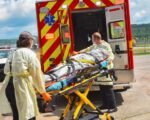In the wake of a devastating hot air balloon crash in Eloy, Arizona, a toxicology report has revealed startling details about the pilot’s condition during the incident. The crash, which claimed the lives of four individuals, has raised serious questions about safety and regulations in recreational aviation.
The Fateful Flight
On a seemingly serene January morning, a hot air balloon took to the skies with thirteen passengers aboard. Among them were eight skydivers, who had planned to leap from the gondola. However, as the balloon ascended, an unforeseen catastrophe unfolded. The balloon’s envelope suffered a catastrophic failure, leading to a rapid descent and a tragic collision with the desert floor.
The pilot, Cornelius Van Der Walt, and three passengers succumbed to the crash, leaving behind a community in mourning. A toxicology report later found that Van Der Walt had significant levels of ketamine in his system, a detail that has cast a shadow over the incident and sparked a debate on the oversight of recreational balloon flights.

Unanswered Questions
The revelation of the pilot’s impaired state has prompted a reevaluation of current policies regarding pilot health and substance use. While the exact influence of the ketamine on the crash remains unclear, the presence of the drug has undeniably added a layer of complexity to the investigation.
Authorities are now scrutinizing the regulatory gaps that may have allowed such a situation to occur. The lack of mandatory drug testing for commercial balloon pilots has come under fire, with many advocating for stricter controls to prevent future tragedies.
Looking to the Future
As the community grapples with the aftermath of the crash, there is a collective call for change. The incident serves as a stark reminder of the inherent risks of flight and the need for rigorous safety measures. The ballooning community, while tight-knit and passionate, recognizes the imperative to reassess and strengthen the standards that protect both pilots and passengers.
In memory of those lost, there is a renewed commitment to ensuring that the joy of flight does not come at the cost of safety. The Eloy balloon crash will undoubtedly serve as a catalyst for reform, with the hope that such an event never occurs again.














